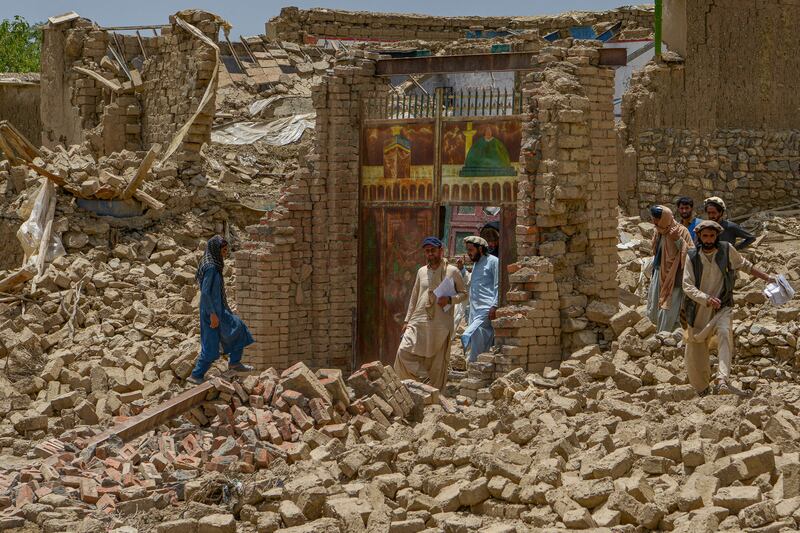Organised rescue efforts were struggling to reach the site of an earthquake in Afghanistan that killed more than 1,000 people, as survivors dig through the rubble by hand to find those still missing.
In Paktika province’s Gayan district, villagers stood atop mud bricks that were once a home. Others carefully walked through dirt alleyways, gripping on to damaged walls with exposed timber beams to make their way.
At least three aftershocks were felt near the earthquake’s epicentre on Thursday, destroying further homes and spreading fear among people in the already worst-hit areas.
“The situation is horrible. Many homes are completely destroyed and toppled over. People say their lives are ruined; some have lost up to eight family members. Most are traumatised,” said Ihsan Hasaand, Emergency Response Lead at Aseel, a local Afghan aid initiative, adding that almost no aid had arrived by Thursday evening in the isolated district, about an eight-hour drive from the capital Kabul.
Owen Doyle: World Rugby should leave the lineout alone and fix the scrum
Oscars 2025: Was Adrien Brody’s speech the longest ever, was Conan O’Brien funny and eight other key questions
Anjelica Huston: ‘There was no shame to having fun with playing women of a certain age’
‘Where I come from, people don’t do medicine. It’s not on your radar’: how a new generation of doctors is being trained
However, as the sun set on Thursday, trucks were travelling the gravel road to Paktika carrying food, blankets and medical supplies and were due to arrive in the early morning hours on Friday.
The catastrophe comes at a time when this country is facing multiple crises — an economy that is collapsing, a humanitarian crisis that is worsening, and a health sector that is barely surviving as money has dried up since August.
“This is shaping up to be one of the worst disasters ever in Afghanistan,” said Samira Sayed-Rahman, the International Rescue Committee’s communications co-ordinator.
The quake was Afghanistan’s deadliest in two decades and officials said the toll could rise. An estimated 1,500 other people were reported injured, the state-run news agency said.
Entire villages have been levelled in some of the worst affected districts, where survivors said they were struggling to find equipment to bury their dead.
“When I came out of my house it was quiet because all the people were buried under their homes. Nothing is left here,” said 21-year-old Zaitullah Ghurziwal.
The quake struck in the early hours of Wednesday morning in an area near the Pakistan border. Rescue efforts have been complicated by the fact that many countries have suspended or cut back on aid to Afghanistan after the Taliban takeover last year.
How and whether the Taliban allow the world to offer aid remained in question as rescuers without heavy equipment dug through rubble as best they could.
In a sign of the muddled workings between the Taliban and the rest of the world, they had not formally requested for the UN to mobilise international search-and-rescue teams or obtain equipment from neighbouring countries to supplement the few dozen ambulances and several helicopters sent in by Afghan authorities, said Ramiz Alakbarov, the UN deputy special representative to Afghanistan.
In a surprising statement late on Thursday – barely a day after the quake – Mohammad Nassim Haqqani, a spokesman for the Taliban’s disaster ministry, announced that rescue operations had finished in major districts although they were continuing in some isolated areas.
A second official echoed Mr Haqqani’s comments. “The rescue operation has finished, no one is trapped under rubble,” Mohammad Ismail Muawiyah, a spokesman for the top Taliban military commander in Paktika province, told Reuters.

Rescue efforts have been further hindered by the rough rural roads and recent heavy rain and hail. “We ask from the Islamic emirate and the whole country to come forward and help us,” said a survivor who gave his name as Hakimullah. “We are with nothing and have nothing, not even a tent to live in.”
The full extent of the destruction among the villages tucked in the mountains was slow in coming to light. However, officials from multiple UN agencies said the Taliban were allowing full access to the area. The UN said its World Food Programme (WFP) was sending food and logistics equipment to affected areas, with the aim of initially supporting 3,000 households. — Guardian













